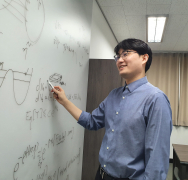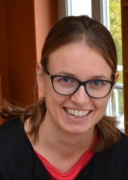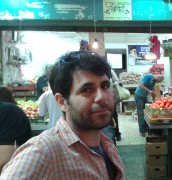 03/11/2021, 17:00 — 18:00 — Sala P3.10, Pavilhão de Matemática Online
03/11/2021, 17:00 — 18:00 — Sala P3.10, Pavilhão de Matemática Online
Luisa Andreis, University of Florence
Phase transition in sparse random graphs and coagulation processes
Inhomogeneous random graphs are a natural generalization of the wellknown Erdös-Renyi random graph, where vertices are characterized by a type and edges are present independently according to the type of the vertices that they are connecting. In the sparse regime, these graphs undergo a phase transition in terms of the emergence of a giant component exactly as the classical Erd}os{R enyi model. In this talk we will present an alternative approach, via large deviations, to prove this phase transition. This allows a comparison with the gelation phase transition that characterizes some coagulation process and with phase transitions of condensation type emerging in several systems of interacting components. This is an ongoing joint work with Wolfgang Koenig (WIAS and TU Berlin), Tejas Iyer (WIAS), Heide Langhammer (WIAS), Robert Patterson (WIAS).
27/10/2021, 17:00 — 18:00 — Online
Luiz Renato Fontes, Universidade de São Paulo
Random walk in a birth-and-death dynamical environment
We consider a particle moving in continuous time as a Markov jump process; its discrete chain given by an ordinary random walk on Z^d (with finite second moments), and its jump rate at (x,t) given by a fixed function f of the state of a simple birth-and-death (BD) process at x on time t. BD processes at different sites are independent and identically distributed, and f is assumed non increasing and vanishing at infinity. We present an argument to obtain a CLT for the particle position when the environment is ergodic. In the absence of a viable uniform lower bound for the jump rate, we resort instead to stochastic domination, as well as to a subadditive argument to control the time spent by the particle to give n jumps (both ingredients rely on the monotonicity of f); and we also impose conditions on the initial (product) environmental initial distribution. We also discuss the asymptotic form of the environment seen by the particle. Joint work with Maicon Pinheiro and Pablo Gomes.
 20/10/2021, 17:00 — 18:00 — Online
20/10/2021, 17:00 — 18:00 — Online
Insuk Seo, Seoul National University
Energy landscape and metastability of Ising/Potts model on lattice without external energy field
In this talk, we consider the Ising and Potts model defined on large lattices of dimension two or three at very low temperature regime. Under this regime, each monochromatic spin configuration is metastable in that exit from the energetic valley around that configuration is exponentially difficult. It is well-known that, under the presence of external magnetic fields, the metastable transition from a monochromatic configuration to another one is characterized solely by the appearance of a critical droplet. On the other hand, for the model without external field, the saddle structure is no longer characterized by a sharp droplet but has a huge and complex plateau structure. In this talk, we explain our recent research on the analysis of this energy landscape and its application to the demonstration of Eyring-Kramers formula for models on fixed two or three dimensional lattice (cf. https://arxiv.org/abs/2102.05565) or models on growing two-dimensional lattice (cf. https://arxiv.org/abs/2109.13583).
This talk is based on joint works with Seonwoo Kim.
13/10/2021, 17:00 — 18:00 — Sala P3.10, Pavilhão de Matemática Online
Jean-Christophe Mourrat, New-York University
Quantitative homogenization of interacting particle systems
I will discuss a class of interacting particle systems in continuous space. Such models are known to "homogenize", in the sense that the behavior of the cloud of particles is approximately described by a partial differential equation over large scales. In the talk, I will describe a first step towards making this result quantitative. The approach is inspired by recent developments in the homogenization of elliptic equations with random coefficients. Joint work with Arianna Giunti and Chenlin Gu.
 06/10/2021, 17:00 — 18:00 — Online
06/10/2021, 17:00 — 18:00 — Online
Marielle Simon, Inria, University of Lille
Hydrodynamic limit for a facilitated exclusion process
In this talk I will present a one-dimensional exclusion process subject to strong kinetic constraints, which belongs to the class of cooperative kinetically constrained lattice gases. More precisely, its stochastic short range interaction exhibits a continuous phase transition to an absorbing state at a critical value of the particle density. We will see that the macroscopic behavior of this microscopic dynamics, under periodic boundary conditions and diffusive time scaling, is ruled by a non-linear PDE belonging to free boundary problems (or Stefan problems). One of the ingredients is to show that the system typically reaches an ergodic component in subdiffusive time. Several questions are still open, I will also give some research directions.
Based on joint works with O. Blondel, C. Erignoux and M. Sasada
 29/09/2021, 17:00 — 18:00 — Sala P3.10, Pavilhão de Matemática Online
29/09/2021, 17:00 — 18:00 — Sala P3.10, Pavilhão de Matemática Online
Stanislav Volkov, Lund University
About discrete Bak-Sneppen model
The discrete version of the famous Bak-Sneppen model (https://en.wikipedia.org/wiki/Bak-Sneppen_model) is a Markov chain on the space of {0,1} sequences of length n with periodic boundary conditions, which runs as follows. Fix some 00.54. This result is indeed correct, however, its proof is not. I shall present the rigorous proof of the Barbay and Kenyon's result, as well as some better bounds for the critical p.
22/09/2021, 17:00 — 18:00 — Sala P3.10, Pavilhão de Matemática Online
Reza Gheissari, UC Berkeley
Cutoff for the Glauber dynamics of the discrete Gaussian free field.
The Gaussian free field (GFF) is a canonical model of random surfaces in probability theory, generalizing the Brownian bridge to higher dimensions. It arises naturally as the stationary solution to the stochastic heat equation with additive noise (SHE), and together the SHE and GFF are expected to be the universal scaling limit of the dynamics and equilibrium of many random surface models arising in lattice statistical physics. We study the mixing time (time to converge to stationarity, when started out of equilibrium) for the central pre-limiting object, the discrete Gaussian free field (DGFF) evolving under the Glauber dynamics. In joint work with S. Ganguly, we establish that for every dimension d larger than one, on a box of side-length $n$ in Zd, the Glauber dynamics for the DGFF exhibits cutoff at time $(d/\pi^2) n^2 \log n$ with an $O(n^2)$ window. Our proof relies on an "exact" representation of the DGFF dynamics in terms of random walk trajectories with space-dependent jump times, which we expect to be of independent interest.
07/07/2021, 17:00 — 18:00 — Sala P3.10, Pavilhão de Matemática Online
Sabine Jansen, University of Munich
Duality, intertwining and orthogonal polynomials for continuum interacting particle systems
Duality is a powerful tool for studying interacting particle systems, i.e., continuous-time Markov processes describing many particles say on the lattice $\mathbb{Z}^d$. In recent years interesting dualities have been proven that involve falling factorials and orthogonal polynomials; the orthogonality measure is the reversible measure of the Markov process. I'll address generalizations to particles moving in the continuum rather than on the lattice. Examples include independent diffusions and free Kawasaki, which have been investigated before, and a continuum version of the symmetric inclusion process, which is new. The falling factorials turn out to be related to Lenard's K-transform. The relevant notion of orthogonal polynomials belongs to infinite-dimensional analysis, Wiener chaos decompositions and multiple stochastic integrals.
Based on joint work with Simone Floreani and Frank Redig (TU Delft) and Stefan Wagner (LMU Munich).
30/06/2021, 17:00 — 18:00 — Online
Servet Martínez, Universidad de Chile
Discrete-time evolution in recombination
We study the discrete-time evolution of a recombination transformation in population genetics acting on the set of measures on genetic sequences. The evolution can be described by a Markov chain on the set of partitions that converges to the finest partition. We describe the geometric decay rate to the limit and the quasi-stationary behavior when conditioned that the chain has not hit the limit.
See also: https://sbp.impa.br
23/06/2021, 17:00 — 18:00 — Online
Yvan Velenik, Université de Genève
Failure of the Ornstein-Zernike asymptotics for the pair correlation function at high temperature and small density
After briefly reviewing what is known about the long-distance asymptotic behavior of the 2-point function in lattice spin systems with finite-range interactions, I'll turn to the corresponding result for systems with interactions of infinite range. I'll show that, contrarily to standard expectations in Physics, the classical Ornstein-Zernike asymptotic formula for the 2-point function does not always hold, even in regimes where it was expected to, namely systems with interactions decaying exponentially fast at very high temperature and/or very low density. I'll explain how this is intimately related to the possible non analytic dependence of the correlation length in the relevant parameters (for instance, temperature), a phenomenon that can occur even in one-dimensional systems. This can be also related to a condensation transition in the graphical representations of these correlations. For simplicity, the focus will be on the Ising model, but most of the results hold much more generally.
16/06/2021, 17:00 — 18:00 — Online
Marianna Russkikh, Massachusetts Institute of Technology
Lozenge tilings and the Gaussian free field on a cylinder
We discuss new results on lozenge tilings on an infinite cylinder, which may be analyzed using the periodic Schur process introduced by Borodin. Under one variant of the $q^{vol}$ measure, corresponding to random cylindric partitions, the height function converges to a deterministic limit shape and fluctuations around it are given by the Gaussian free field in the conformal structure predicted by the Kenyon-Okounkov conjecture. Under another variant, corresponding to an unrestricted tiling model on the cylinder, the fluctuations are given by the same Gaussian free field with an additional discrete Gaussian shift component. Fluctuations of the latter type have been previously conjectured by Gorin for tiling models on planar domains with holes. This talk is based on joint work with Andrew Ahn and Roger Van Peski.
02/06/2021, 17:00 — 18:00 — Online
Reda Chhaibi, Institut de Mathématiques de Toulouse
Kahane's Gaussian Multiplicative Chaos and Circular Random Matrices match exactly
In this talk, I would like to advertise the strict equality between two objects from very different areas of mathematical physics:
- Kahane's Gaussian Multiplicative Chaos (GMC), which uses a log-correlated field as input and plays an important role in certain conformal field theories
- A reference model in random matrices called the Circular Beta Ensemble (CBE).
The goal is to give a precise theorem whose loose form is GMC = CBE. Although it was known that random matrices exhibit log-correlated features, such an exact correspondence is quite a surprise.
26/05/2021, 17:00 — 18:00 — Online
Eugene Speer, Rutgers University
Facilitated Exclusion Processes
Facilitated exclusion processes are lattice gasses in which a particle with an empty neighboring site can jump to that site only if it has also an occupied neighboring site. We will discuss three such models in one dimension, for both discrete-time and continuous-time dynamics and with varying degrees of asymmetry. We address two questions: What are the possible translation invariant stationary states? If the initial state is Bernoulli, what is the final state? This is joint work with Arvind Ayyer, Shelly Goldstein, and Joel Lebowitz.
 19/05/2021, 17:00 — 18:00 — Sala P3.10, Pavilhão de Matemática Online
19/05/2021, 17:00 — 18:00 — Sala P3.10, Pavilhão de Matemática Online
Tal Orenshtein, Weierstrass Institute and TU Berlin
Rough walks in random environment
Random walks in random environment (RWRE) have been extensively studied in the last half-century. Functional central limit theorems (FCLT) hold in some prototypical classes such the reversible and the ballistic ones. The latter are treated using rather different techniques; Kipnis-Varadhan's theory for additive functionals of Markov processes is applicable in the reversible case whereas the main feature exploited in the ballistic class is a regeneration structure. Rough path theory is a deterministic theory which extends classical notions of integration to singular integrators in a continuous manner. It typically provides a framework for pathwise solutions of ordinary and partial stochastic differential equations driven by a singular noise. In the talk we shall discuss FCLT for additive functionals of Markov processes and regenerative processes lifted to the rough path space. The limiting rough path has two levels. The first one is the Brownian motion, whereas in the second we see a new feature: it is the iterated integral of the Brownian motion perturbed by a deterministic linear function called the area anomaly. The aforementioned classes of RWRE are covered as special cases. The results provide sharper information on the limiting path. In addition, the construction of new examples for SDE approximations is an immediate application.
Based on collaborations (some still in progress) with Johannes Bäumler, Noam Berger, Jean-Dominique Deuschel, Olga Lopusanschi, Nicolas Perkowski and Martin Slowik.
References
- Additive functionals as rough paths, with Jean-Dominique Deuschel and Nicolas Perkowski, Ann. Probab. 49(3): 1450-1479 (May 2021). DOI: 10.1214/20-AOP1488.
- Ballistic random walks in random environment as rough paths: convergence and area anomaly, with Olga Lopusanschi, ALEA, Lat. Am. J. Probab. Math. Stat. 18, 945–962 (April 2021) DOI: 10.30757/ALEA.v18-34.
- Rough invariance principle for delayed regenerative processes, arXiv:2101.05222.
05/05/2021, 17:00 — 18:00 — Online
Rangel Baldasso, University of Leiden
Sharp thresholds for Glauber dynamics percolation
Sharp threshold is a phenomena that characterizes abrupt change of behavior in a phase transition. In this talk, we prove that the two-dimensional model obtained by running Glauber dynamics up to some finite time yields a percolation model that presents a sharp threshold. The proof is based on special properties of a graphical construction of the model that allows us to pass from annealed to quenched measurements. Based on a joint work with C. Alves, G. Amir, and A. Teixeira.
 21/04/2021, 17:00 — 18:00 — Online
21/04/2021, 17:00 — 18:00 — Online
Yinon Spinka, University of British Columbia
A tale of two balloons
From each point of a Poisson point process start growing a balloon at rate 1. When two balloons touch, they pop and disappear. Will balloons reach the origin infinitely often or not? We answer this question for various underlying spaces. En route we find a new(ish) 0-1 law, and generalize bounds on independent sets that are factors of IID on trees. Joint work with Omer Angel and Gourab Ray.
Note that we are now a joint probability seminar with IMPA. See here: https://sbp.impa.br
14/04/2021, 17:00 — 18:00 — Online
Gioia Carinci, Università degli Studi di Modena e Reggio Emilia
Condensation of SIP particles and sticky Brownian motions
The symmetric inclusion process (SIP) is a particle system with attractive interaction. We study its behavior in the condensation regime attained for large values of the attraction intensity. Using Mosco convergence of Dirichlet forms, we prove convergence to sticky Brownian motion for the distance of two SIP particles. We use this result to obtain, via duality, an explicit scaling for the variance of the density field in this regime, for the SIP initially started from a homogeneous product measure. This provides relevant new information on the coarsening dynamics of condensing particle systems on the infinite lattice. Joint work with M. Ayala and F. Redig.
Note that we are now a joint probability seminar with IMPA. See here: https://spmes.impa.br/
 07/04/2021, 17:00 — 18:00 — Sala P3.10, Pavilhão de Matemática Online
07/04/2021, 17:00 — 18:00 — Sala P3.10, Pavilhão de Matemática Online
Herbert Spohn, Technical University of Munich
Hydrodynamic equations for the classical Toda lattice
The Toda lattice is one of the most famous integrable system of classical mechanics. For N lattice sites there are $N+1$ conserved quantities. We are interested in the hydrodynamic scale, which means to start with suitably adjusted random initial data. In my talk I will outline the general structure and the resulting hydrodynamic Euler type equations. An unexpected connection to the repulsive log gas in one dimension is discussed.
31/03/2021, 17:00 — 18:00 — Online
Daniel Kious, University of Bath
Random walk on the simple symmetric exclusion process
In a joint work with Marcelo R. Hilário and Augusto Teixeira, we investigate the long-term behavior of a random walker evolving on top of the simple symmetric exclusion process (SSEP) at equilibrium. At each jump, the random walker is subject to a drift that depends on whether it is sitting on top of a particle or a hole. The asymptotic behavior is expected to depend on the density $\rho$ in $[0, 1]$ of the underlying SSEP. Our first result is a law of large numbers (LLN) for the random walker for all densities ρ except for at most two values $\rho^-$ and $\rho^+$ in $[0, 1]$, where the speed (as a function fo the density) possibly jumps from, or to, $0$. Second, we prove that, for any density corresponding to a non-zero speed regime, the fluctuations are diffusive and a Central Limit Theorem holds. Our main results extend to environments given by a family of independent simple symmetric random walks in equilibrium.
 17/03/2021, 17:00 — 18:00 — Sala P3.10, Pavilhão de Matemática Online
17/03/2021, 17:00 — 18:00 — Sala P3.10, Pavilhão de Matemática Online
Cristian Giardinà, Università degli Studi di Modena e Reggio Emilia
Exact solution of an integrable particle system
We consider the family of boundary-driven models introduced in [FGK] and show they can be solved exactly, i.e. the correlations functions and the non-equilibrium steady-state have a closed-form expression.
The solution relies on probabilistic arguments and techniques inspired by integrable systems. As in the context of bulk-driven systems (scaling to KPZ), it is obtained in two steps: i) the introduction of a dual process; ii) the solution of the dual dynamics by Bethe ansatz.
For boundary-driven systems, a general by-product of duality is the existence of a direct mapping (a conjugation) between the generator of the non-equilibrium process and the generator of the associated reversible equilibrium process. Macroscopically, this mapping was observed years ago by Tailleur, Kurchan and Lecomte in the context of the Macroscopic Fluctuation Theory.
[FGK] R. Frassek, C. Giardinà, J. Kurchan, Non-compact quantum spin chains as integrable stochastic particle processes, Journal of Statistical Physics 180, 366-397 (2020).
Ver também
giardina-lisbon-17march-2021.pdf
Please note change of day and time. Joint session with Seminario Brasileiro de Probabilidade: https://sbp.impa.br
